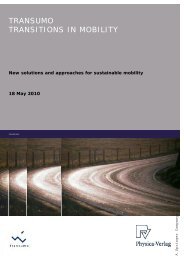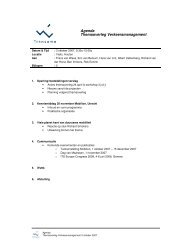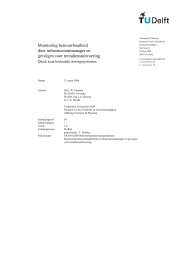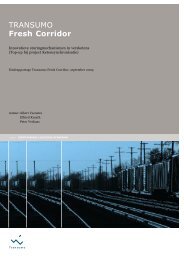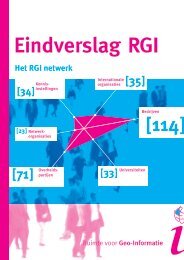Casestudie Breakdown prediction Contell PILOT - Transumo
Casestudie Breakdown prediction Contell PILOT - Transumo
Casestudie Breakdown prediction Contell PILOT - Transumo
You also want an ePaper? Increase the reach of your titles
YUMPU automatically turns print PDFs into web optimized ePapers that Google loves.
P<br />
( m)<br />
= P<br />
( r )<br />
⋅ P<br />
( m−r<br />
)<br />
with<br />
P<br />
( m)<br />
=<br />
( m)<br />
( p ) m = 1,2, K<br />
ij<br />
Formula 5-17: Formula of Chapman-Kolmogorov (Simplified Version)<br />
This simplified Formula 5-17 allows an argumentation that shows that every Markov<br />
chain can be described completely by just giving a starting distribution at step 0 and<br />
a transition matrix. 55<br />
As mentioned above, a Markov chain is often used to predict breakdowns. Therefore,<br />
the existing states have to be classified as critical and uncritical ones. In general,<br />
states<br />
i ∈ I with p = 1 are critical ones. They are called absorbing states. Figure 5-5<br />
ii<br />
contains two absorbing states because after taking state 0 or 6 all following states<br />
will remain the same. Markov chains can now be used to determine the probability a<br />
critical state is taken. If an absorbing state is taken with a probability of one hundred<br />
percent, the mean number of steps can also be determined after which an absorbing<br />
state is taken. ([Waldmann04], p. 18)<br />
This determination can be done by calculating<br />
( )<br />
P m<br />
with m = 1,2, K,<br />
∞ . Markov chains<br />
often converge to a stationary distribution, so that the probability for an absorbing<br />
state can be given for an infinite number of state changes. Formula 5-18 introduces a<br />
counter-example that does not converge. Hence, the probability an absorbing state is<br />
taken during the whole processing time of the Markov chain cannot be obtained in<br />
any case but in many cases. ([Waldmann04], p. 40)<br />
⎛0<br />
P = ⎜<br />
⎝1<br />
1⎞<br />
⎟<br />
0⎠<br />
Formula 5-18: Identity Matrix as an Example of a non Converging Markov Chain<br />
The Markov property can also be transferred to the setting of time-continuous<br />
stochastic processes. The result is called Markov process. The biggest difference to<br />
the Markov chains is the non-applicability of the above described state probability<br />
calculations. The results can no longer be determined by just multiplying matrices but<br />
by solving differential equations. To ease calculations the underlying process is often<br />
55 See ([Beichelt97], p. 148) for details<br />
71



